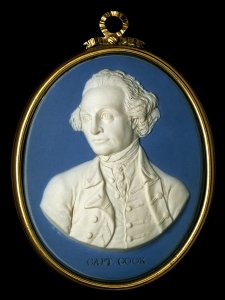Trade and Discovery
Enlightenment
Discovering the world in the Eighteenth century: see the British Museum website, Enlightenment.
Trade and discovery

- Captain James Cook
- [click on the picture to enlarge it]
Sir Hans Sloane’s collection included ceremonial and every day objects representing customs and cultures of people around the globe. They formed the beginnings of an ethnographic collection that grew through the century as men like Captain James Cook and Sir Joseph Banks returned from voyages of trade and discovery to Australia, New Zealand, Tahiti and other Pacific islands.
Others were sent by the Admiralty to discover the Northwest Passage through the Arctic or by the government to forge or mend diplomatic relations. Meanwhile officials of the East India and other great trading companies studied the cultures of the people with whom they lived, collected further artefacts and published illustrated accounts that provided information about the lives and cultures of people around the world.
Christopher Columbus is said to have ’discovered’ America in 1492, but we know now that Vikings began visiting the northeast coast from the tenth century. In any case, America was hardly a ’discovery’ to the peoples who already lived there.
The Americas
By the beginning of the eighteenth century, South America and the Caribbean had been exploited by the Spanish for centuries, and more recently also by the British. In Central America, Maya and Aztec ruins presented tantalising glimpses of ancient civilisations. The eastern part of North America included a series of well-established British colonies fighting the French for control of Canada, and later for their own independence from Britain. Native populations were devastated by epidemics and warfare, and their culture was suppressed by Europeans.
The Pacific
In the middle of the eighteenth century voyagers from Europe began to join the many skilled island navigators who had been sailing the Pacific Ocean for centuries.
Asia
Asia had always exerted a fascination on the people of Europe. They saw it as a world of exotic peoples and religions and richly decorated porcelain, sculpture, jewels and textiles.
Egypt and Africa
In the eighteenth century there were many people of African ancestry living at all levels of British society. Trade and cultural exchange between Africa and Europe had been established for many centuries.

